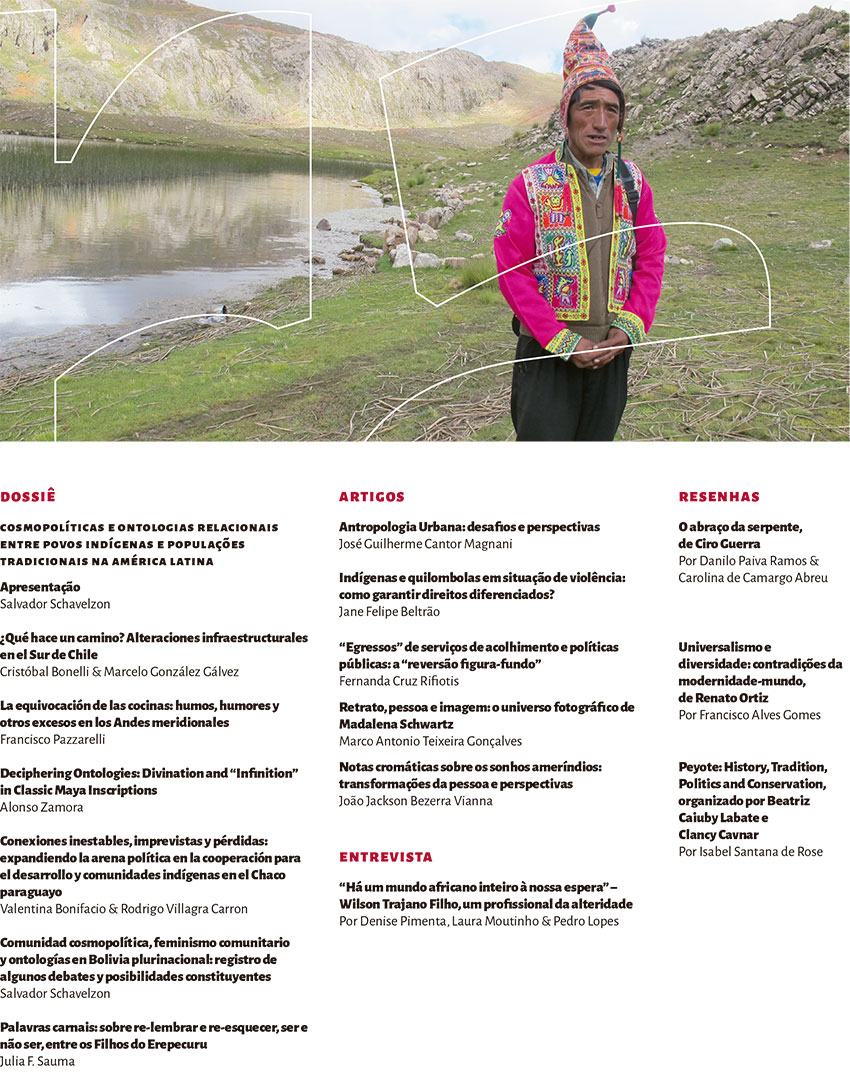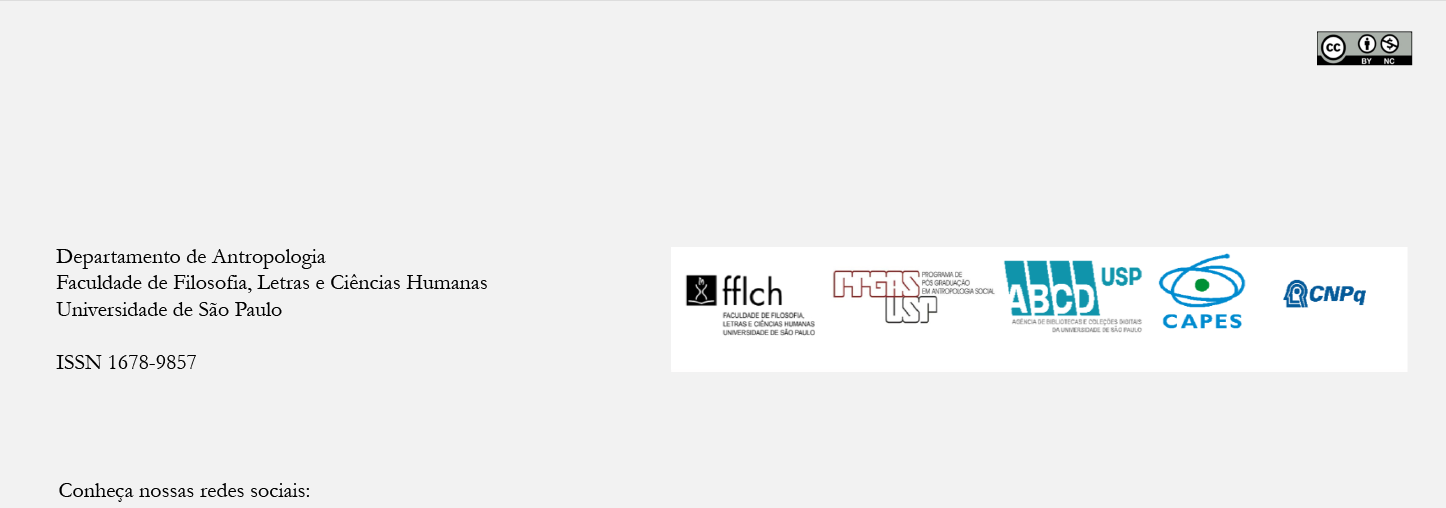Deciphering Ontologies: Divination and "Infinition" in Classic Maya Inscriptions
DOI:
https://doi.org/10.11606/2179-0892.ra.2016.124808Palavras-chave:
Maya Art, Long Count, Palenque, Maya Epigraphy, Ritual, Power, Divination, InfinitionResumo
In many forms, important trends of current anthropology, like the ontological turn, have been left aside in the analysis of the ancient artistic testimonies of the indigenous people of the Americas, thanks to the inevitable gap and lamentable misunderstandings between ethnology, archaeology and art history. In this text, we retake the notion of "infinition", a term coined by Martin Holbraad in his work about Cuban divination, Truth in Motion (2012), to explore two epigraphic and artistic testimonies from the courts of the Classic Maya period (ad 250-900) and see how what has been seen as mere calendarical manipulation by scheming rulers and elites can be read as ritual acts of divination which created new identities, altered the ontological constitution of their participants and challenged the boundaries of human (and divine) time and space. By reading Maya art à la Roy Wagner, that is, as invention, we want to encourage the very much needed criticism of the tired notion of "justification of power" that seems to pervade Maya Art interpretation among archaeologists and epigraphists.Downloads
Referências
BERLIN, Heinrich. 1958. “Glifos nominales en el sarcófago de Palenque: un ensayo”. in Humanidades 2 (10): 1-8, Guatemala: Facultad de Humanidades de la Universidad de San Carlos de Guatemala.
BERNAL ROMERO, Guillermo. 2002. “U Pakal K’inich Janahb’ Pakal, el Nuevo gobernador de Palenque”. Lakamha’, Palenque, Conaculta inah, 1(4):4-9.
CALLAWAY, Carl. 2006. “The Birth of the Number Twenty in the Dresden Codex”, <http://docs.google.com/Doc?id=dm89jhb_35hprnq8c8&hl=en>, electronic document [August 24, 2014].
DANIELS, Peter T. and BRIGHT, William (eds.). 1996. The World’s Writing Systems. Oxford, Oxford University Press.
DEMAREST, Arthur. 2004. Ancient Maya: The Rise and Fall of a Rainforest Civilization, Cambridge, Cambridge University Press.
HOLBRAAD, Martin. 2006. “The Power of Powder: Multiplicity and Motion in the Divinatory Cosmology of Cuban Ifa (or Mana, Again)”.
HENARE, A.; HOLBRAAD, M. and WASTELL, S. (eds.), Thinking through Things: Theorising Artefacts Ethnographically. Abingdon, Routledge, pp. 189-225.
HENARE, A.; HOLBRAAD, M. and WASTELL, S. 2012. Truth In Motion: The Recursive Anthropology Of Cuban Divination. Chicago, University of Chicago Press.
HOUSEMAN, Michael and SEVERI, Carlo. 1998. Naven or the Other Self: A Relational Approach to Ritual Action. Leiden, Brill.
HOUSTON, Stephen; MAZARIEGOS, Oswaldo Chinchilla and STUART, David. 2001. The Decipherment of Ancient Maya Writing. Oklahoma, Oklahoma Press.
MARCUS, Joyce. 1992. Mesoamerican Writing Systems: Propaganda, Myth, and History in Four Ancient Civilizations. Princeton, Princeton University Press.
NAVARRETE, Federico. 2010. “Descifrar el mundo maya: Una selva de Reyes, de Linda Schele, y El cosmos maya, de Linda Schele, David Freidel y Joy Parker”. In Letras Libres, 17, Mexico, Vuelta, p. 96.
PROSKOURIAKOFF, Tatiana. 1960. “Historical Implications of a Pattern of Dates at Piedras Negras, Guatemala”. American Antiquity, Washington, Society for American Archaeology, 25: 454-75.
VELÁSQUEZ GARCÍA, Erik. 2011. “Los mayas y las concepciones del tiempo”, session 2 of the vii Mesa Redonda de Palenque. Unpublished manuscript.
SANTLEY, Robert. 1989. “Writing Systems, Political Power and the Internal Structure of Early States in Precolumbian Mesoamerica”. In TKACZUK, D. C. and VIVIAN, B. C. (eds.), Cultures in Conflict: Current Archaeological Perspectives . Calgary, The Archaeological Association of the University of Calgary, pp. 90-102.
SCHELE, Linda. 1985. “The Hauberg Stela: Bloodletting and the Mythos of Classic Maya Rulership”. In FIELDS, V.M. (ed.), Fifth Palenque Round Table. San Francisco, The Pre-Columbian Art Research Institute, pp. 135-151.
SCHELLHAS, Paul. 1904. “Representation of Deities in Maya Manuscripts”. Papers of the Peabody Museum of American Archaeology and Ethnology, Cambridge, Peabody Museum, Harvard University, vol. 4, n. 1.
SPENCER, Kaelee Ree. 2007. Framing the Portrait: Towards an Understanding of Elite Late Classic Maya Representation at Palenque, Mexico. Austin, University of Texas at Austin.
STUART, David. 1995. A Study on Maya Inscriptions. Nashville, doctoral dissertation, Vanderbilt University.
STUART, David. 2005a. The Inscriptions from Temple xix at Palenque: a Commentary. San Francisco, The Precolumbian Art Research Center.
STUART, David. 2005b. “The Palenque Mythology”. Sourcebook for the 2005 Maya Meetings, Austin, The Mesoamerica Center, Department of Art and Art History, University of Texas.
STUART, David. 2012. “The Name of Paper: The Mythology of Crowning and Royal Nomenclature on Palenque’s Palace Tablet”. Maya Archaeology 2, San Francisco, Precolumbian Mesoweb Press.
VARGAS PACHECO, Ernesto. 2010. “Legitimizing Royalty among Late Preclassic Maya. The Masks from El Tigre-Campeche”. Estudios de Cultura Maya, Mexico, Universidad Nacional Autonoma de México, vol.36: 11-35.
VIVEIROS DE CASTRO, Eduardo. 1992. From the Enemy’s Point of View: Humanity and Divinity in an Amazonian Society. Chicago, University of Chicago Press.
WAGNER, Roy. 1973. Habu: The Innovation of Meaning in Daribi Religion. Chicago, University of Chicago Press.
WAGNER, Roy. 1981. The Invention of Culture. Revised and expanded edition. Chicago: University of Chicago Press.
WICHMANN, Søren (ed.). 2004. The Linguistics of Maya Writing. Salt Lake City, University of Utah Press.
Downloads
Publicado
Edição
Seção
Licença
Copyright (c) 2016 Revista de Antropologia

Este trabalho está licenciado sob uma licença Creative Commons Attribution 4.0 International License.
Autores que publicam na Revista de Antropologia concordam com os seguintes termos:
a) Autores mantém os direitos autorais e concedem à revista o direito de primeira publicação, com o trabalho simultaneamente licenciado sob a Licença Creative Commons Attribution que permite o compartilhamento do trabalho com reconhecimento da autoria e publicação inicial nesta revista.
b) Autores têm autorização para assumir contratos adicionais separadamente, para distribuição não-exclusiva da versão do trabalho publicada nesta revista (ex.: publicar em repositório institucional ou como capítulo de livro), com reconhecimento de autoria e publicação inicial nesta revista.
c) Autores têm permissão e são estimulados a publicar e distribuir seu trabalho online (ex.: em repositórios institucionais ou na sua página pessoal) após o processo editorial, já que isso pode gerar alterações produtivas, bem como aumentar o impacto e a citação do trabalho publicado (Veja O Efeito do Acesso Livre).




